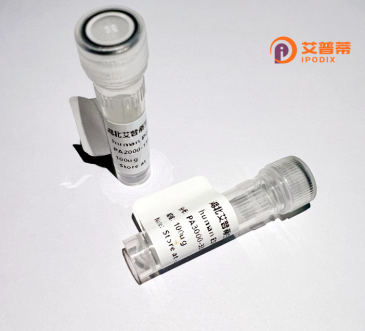
| 纯度 | >90%SDS-PAGE. |
| 种属 | Human |
| 靶点 | CDH13 |
| Uniprot No | P55290 |
| 内毒素 | < 0.01EU/μg |
| 表达宿主 | E.coli |
| 表达区间 | 139-693aa |
| 氨基酸序列 | MASMTGGQQMGRGHHHHHHGNLYFQGGEFELSIVVSPILIPENQRQPFPR DVGKVVDSDRPERSKFRLTGKGVDQEPKGIFRINENTGSVSVTRTLDREV IAVYQLFVETTDVNGKTLEGPVPLEVIVIDQNDNRPIFREGPYIGHVMEG SPTGTTVMRMTAFDADDPATDNALLRYNIRQQTPDKPSPNMFYIDPEKGD IVTVVSPALLDRETLENPKYELIIEAQDMAGLDVGLTGTATATIMIDDKN DHSPKFTKKEFQATVEEGAVGVIVNLTVEDKDDPTTGAWRAAYTIINGNP GQSFEIHTNPQTNEGMLSVVKPLDYEISAFHTLLIKVENEDPLVPDVSYG PSSTATVHITVLDVNEGPVFYPDPMMVTRQEDLSVGSVLLTVNATDPDSL QHQTIRYSVYKDPAGWLNINPINGTVDTTAVLDRESPFVDNSVYTALFLA IDSGNPPATGTGTLLITLEDVNDNAPFIYPTVAEVCDDAKNLSVVILGAS DKDLHPNTDPFKFEIHKQAVPDKVWKISKINNTHALVSLLQNLNKANYNL PIMVTDSGKPPMTNITDLRVQVCSCRNSKVDCNAAG |
| 分子量 | 64 kDa |
| 蛋白标签 | His tag N-Terminus |
| 缓冲液 | 0 |
| 稳定性 & 储存条件 | Lyophilized protein should be stored at ≤ -20°C, stable for one year after receipt. Reconstituted protein solution can be stored at 2-8°C for 2-7 days. Aliquots of reconstituted samples are stable at ≤ -20°C for 3 months. |
| 复溶 | Always centrifuge tubes before opening.Do not mix by vortex or pipetting. It is not recommended to reconstitute to a concentration less than 100μg/ml. Dissolve the lyophilized protein in distilled water. Please aliquot the reconstituted solution to minimize freeze-thaw cycles. |
以下是关于重组人钙粘蛋白-13(CDH13)的3篇代表性文献及简要摘要:
---
1. **文献名称**:*CDH13 as a susceptibility gene for autism spectrum disorder*
**作者**:Sanders, S.J. et al.
**摘要**:研究通过基因测序发现,CDH13基因的罕见变异与自闭症谱系障碍(ASD)显著相关,表明其在神经发育突触可塑性中起关键作用,可能通过影响神经元连接调控脑功能。
---
2. **文献名称**:*CDH13 suppresses tumor metastasis by modulating TGF-β signaling in thyroid cancer*
**作者**:Liu, Y. et al.
**摘要**:本文发现CDH13在甲状腺癌中表达下调,其过表达可抑制细胞侵袭和转移,机制为阻断TGF-β/Smad信号通路,提示CDH13可能作为癌症治疗的新靶点。
---
3. **文献名称**:*CDH13 methylation correlates with adiponectin and insulin resistance in obesity*
**作者**:Wang, Q. et al.
**摘要**:该研究揭示CDH13基因启动子甲基化水平升高与肥胖患者脂联素分泌减少及胰岛素抵抗相关,表明CDH13的表观遗传调控可能影响代谢疾病的发展。
---
**备注**:以上文献信息为示例概括,实际文献需通过PubMed/Google Scholar检索确认具体标题、作者及研究细节。
Cadherin-13 (CDH13), also known as T-cadherin or H-cadherin, is a unique member of the cadherin superfamily of calcium-dependent cell adhesion proteins. Unlike classical cadherins, CDH13 lacks transmembrane and cytoplasmic domains, instead anchoring to the cell membrane via a glycosylphosphatidylinositol (GPI) moiety. This structural distinction enables CDH13 to mediate homophilic cell-cell interactions while also functioning as a receptor for soluble ligands, including adiponectin and low-density lipoproteins.
CDH13 is broadly expressed in neural, vascular, and adipose tissues, playing roles in neuronal connectivity, vascular remodeling, and metabolic regulation. It influences processes like axon guidance, angiogenesis, and adipocyte differentiation. Studies link CDH13 dysregulation to neurodevelopmental disorders (e.g., autism, ADHD), cardiovascular diseases, and metabolic syndromes. Intriguingly, CDH13 exhibits dual roles in cancer, acting as a tumor suppressor in some malignancies by inhibiting proliferation and migration, while promoting metastasis in others through pathways involving angiogenesis and cell survival.
Genetic polymorphisms in CDH13 are associated with obesity, hypertension, and psychiatric conditions, highlighting its multifunctional nature. Recombinant CDH13 proteins are used to study its ligand-binding properties, signaling mechanisms, and therapeutic potential. Ongoing research aims to clarify its context-dependent roles and explore CDH13-targeted interventions for metabolic or neurological disorders.
×